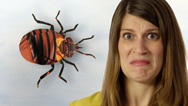Why Get Your Tetanus Shot?
- By Anna Rothschild
- Posted 10.01.15
- NOVA
Avoiding your tetanus shot? Find out why that might be a bad idea in this episode of Gross Science.
Transcript
Why Get Your Tetanus Shot?
Posted: October 1, 2015
I have this friend who bikes to work everyday, goes hiking in her spare time, and yet… because she’s scared of needles, she refuses to get a tetanus shot. Here’s why that might be a bad idea.
I’m Anna Rothschild, and this is Gross Science.
Tetanus is caused by the bacterium Clostridium tetani, which lives all around us on things like soil, dust, or rusty nails. When it’s in the environment, it exists as something called an “endospore,” which is a hibernation-like state that can last for decades. But once it enters an oxygen-free place, like, say, the cut on your elbow when you fall off your bike, it starts to replicate and release toxins. The toxins enter your nervous system, and that’s when things take a really bad turn.
One of the early symptoms of the disease is lockjaw—essentially muscle spasms that make it difficult to speak or eat. Some patients’ faces will freeze into an eerie grin, called “risus sardonicus.” And as the disease progresses, other parts of the nervous system become affected, as well. It can cause something called “opisthotonos,” where the back and neck muscles spasm, causing the body to contort into an arch, and sometimes even breaking bones. Patients can become immobilized, and have fevers, difficulty breathing, and heart attacks. With medical care, tetanus is treatable, though recovery can take months, and there’s still around a 10% chance of death.
Today in America, most of us are vaccinated for tetanus as children, which is probably why there was an average of only 29 cases per year from 2001 to 2008. But the CDC recommends that every 10 years or so, adults re-up their resistance to the disease with a tetanus “booster shot.” And if the horrifying symptoms I’ve mentioned so far don’t compel you to get your booster, know that the shot also comes with a vaccine for diphtheria, and sometimes whooping cough, too! So, that’s a bonus.
By the way, whooping cough and tetanus are both extremely dangerous to newborns, so pregnant women are especially encouraged to get vaccinated because they can pass on some level of protection to their babies.
Listen, do what you need to do to feel happy and healthy. But if you plan to live an active life and don’t get vaccinated, be prepared to accept the possibility of tetanus, and the muscles spasms that come with it.
Ew.
Credits
PRODUCTION CREDITS
- Host, Writer, Animator, Editor
- Anna Rothschild
- DP, Sound
- Ceri Riley
- Many thanks to Dr. William Schaffner, Infectious Disease Specialist and Professor of Preventive Medicine, Vanderbilt University School of Medicine
- Slow Bass
- Music Provided by APM
IMAGES AND VIDEO
- Clostridium tetani
- Wikimedia Commons/CDC
- Paardenstalmest Horse manure
- Wikimedia Commons/Rasbak
- Dust bunnies
- Wikimedia Commons/Stromcarlson
- Roman era wrought iron nail – Province of Pannonia II. Century – Hungary
- Wikimedia Commons/Takkk
- Woman riding a bike
- Wikimedia Commons/National Cancer Institute
- Lock-jaw 2857
- Wikimedia Commons/CDC
- Opisthotonus in a patient suffering from tetanus – Painting by Sir Charles Bell – 1809
- Wikimedia Commons/Sir Charles Bell
- Face on man with tetanus
- CDC
- Doctor Doing Vaccine Injection To A Child
- Pond5/GekaSkr
- Dirty white pseudomembrane classically seen in diphtheria 2013-07-06 11-07
- Wikimedia Commons/User:Dileepunnikri
- Pertussis
- Wikimedia Commons/CDC
- Sleeping newborn infant
- Wikimedia Commons/Andrés Nieto Porras
- 31 weeks pregnant
- Flickr/Jerry Lai
SFX
- Cockroaches
- Freesound/StateAardvark
(used with permission from author) - Squeak Pack/squeak_10
- Freesound/Corsica_S
- Poof of smoke
- Freesound/planman
- Wink
- Freesound/bennychico11
- Produced by WGBH for PBS Digital Studios
POSTER IMAGE
- Opisthotonus in a patient suffering from tetanus – Painting by Sir Charles Bell – 1809
- Wikimedia Commons/Sir Charles Bell
Sources
Want more info?
Tetanus Info from the CDC:
http://www.cdc.gov/tetanus/about/index.html
http://www.cdc.gov/vaccines/pubs/pinkbook/tetanus.html
Maternal and Neonatal Tetanus elimination, from WHO:
http://www.who.int/immunization/diseases/MNTE_initiative/en/
Diphtheria Info from the CDC:
http://www.cdc.gov/vaccines/pubs/pinkbook/downloads/dip.pdf
http://www.cdc.gov/diphtheria/clinicians.html
Pertussis Info from the CDC:
http://www.cdc.gov/pertussis/
Related Links
-

Gross Science
Bizarre stories from the slimy, smelly, creepy world of science.
-

Ancient Cataract Surgery
Doctors have attempted to remove cataracts for thousands of years.
-

What is the Black Plague?
Plague sounds like a medieval disease, but there are a few cases in the US every year.
-

Vaccines—Calling the Shots
Examine the science behind vaccinations, the return of preventable diseases, and the risks of opting out.

